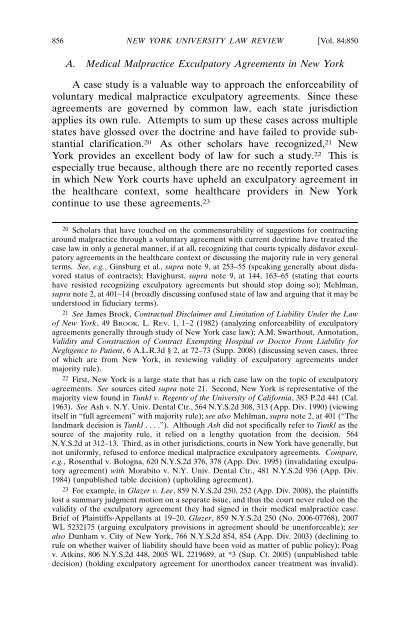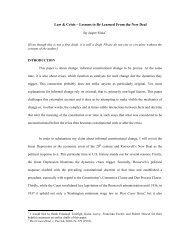In Search of an Enforceable Medical Malpractice Exculpatory
In Search of an Enforceable Medical Malpractice Exculpatory
In Search of an Enforceable Medical Malpractice Exculpatory
You also want an ePaper? Increase the reach of your titles
YUMPU automatically turns print PDFs into web optimized ePapers that Google loves.
856 NEW YORK UNIVERSITY LAW REVIEW [Vol. 84:850<br />
A. <strong>Medical</strong> <strong>Malpractice</strong> <strong>Exculpatory</strong> Agreements in New York<br />
A case study is a valuable way to approach the enforceability <strong>of</strong><br />
voluntary medical malpractice exculpatory agreements. Since these<br />
agreements are governed by common law, each state jurisdiction<br />
applies its own rule. Attempts to sum up these cases across multiple<br />
states have glossed over the doctrine <strong>an</strong>d have failed to provide subst<strong>an</strong>tial<br />
clarification. 20 As other scholars have recognized, 21 New<br />
York provides <strong>an</strong> excellent body <strong>of</strong> law for such a study. 22 This is<br />
especially true because, although there are no recently reported cases<br />
in which New York courts have upheld <strong>an</strong> exculpatory agreement in<br />
the healthcare context, some healthcare providers in New York<br />
continue to use these agreements. 23<br />
20 Scholars that have touched on the commensurability <strong>of</strong> suggestions for contracting<br />
around malpractice through a voluntary agreement with current doctrine have treated the<br />
case law in only a general m<strong>an</strong>ner, if at all, recognizing that courts typically disfavor exculpatory<br />
agreements in the healthcare context or discussing the majority rule in very general<br />
terms. See, e.g., Ginsburg et al., supra note 9, at 253–55 (speaking generally about disfavored<br />
status <strong>of</strong> contracts); Havighurst, supra note 9, at 144, 163–65 (stating that courts<br />
have resisted recognizing exculpatory agreements but should stop doing so); Mehlm<strong>an</strong>,<br />
supra note 2, at 401–14 (broadly discussing confused state <strong>of</strong> law <strong>an</strong>d arguing that it may be<br />
understood in fiduciary terms).<br />
21 See James Brock, Contractual Disclaimer <strong>an</strong>d Limitation <strong>of</strong> Liability Under the Law<br />
<strong>of</strong> New York, 49 BROOK. L. REV. 1, 1–2 (1982) (<strong>an</strong>alyzing enforceability <strong>of</strong> exculpatory<br />
agreements generally through study <strong>of</strong> New York case law); A.M. Swarthout, Annotation,<br />
Validity <strong>an</strong>d Construction <strong>of</strong> Contract Exempting Hospital or Doctor From Liability for<br />
Negligence to Patient, 6 A.L.R.3d § 2, at 72–73 (Supp. 2008) (discussing seven cases, three<br />
<strong>of</strong> which are from New York, in reviewing validity <strong>of</strong> exculpatory agreements under<br />
majority rule).<br />
22 First, New York is a large state that has a rich case law on the topic <strong>of</strong> exculpatory<br />
agreements. See sources cited supra note 21. Second, New York is representative <strong>of</strong> the<br />
majority view found in Tunkl v. Regents <strong>of</strong> the University <strong>of</strong> California, 383 P.2d 441 (Cal.<br />
1963). See Ash v. N.Y. Univ. Dental Ctr., 564 N.Y.S.2d 308, 313 (App. Div. 1990) (viewing<br />
itself in “full agreement” with majority rule); see also Mehlm<strong>an</strong>, supra note 2, at 401 (“The<br />
l<strong>an</strong>dmark decision is Tunkl . . . .”). Although Ash did not specifically refer to Tunkl as the<br />
source <strong>of</strong> the majority rule, it relied on a lengthy quotation from the decision. 564<br />
N.Y.S.2d at 312–13. Third, as in other jurisdictions, courts in New York have generally, but<br />
not uniformly, refused to enforce medical malpractice exculpatory agreements. Compare,<br />
e.g., Rosenthal v. Bologna, 620 N.Y.S.2d 376, 378 (App. Div. 1995) (invalidating exculpatory<br />
agreement) with Morabito v. N.Y. Univ. Dental Ctr., 481 N.Y.S.2d 936 (App. Div.<br />
1984) (unpublished table decision) (upholding agreement).<br />
23 For example, in Glazer v. Lee, 859 N.Y.S.2d 250, 252 (App. Div. 2008), the plaintiffs<br />
lost a summary judgment motion on a separate issue, <strong>an</strong>d thus the court never ruled on the<br />
validity <strong>of</strong> the exculpatory agreement they had signed in their medical malpractice case.<br />
Brief <strong>of</strong> Plaintiffs-Appell<strong>an</strong>ts at 19–20, Glazer, 859 N.Y.S.2d 250 (No. 2006-07768), 2007<br />
WL 5232175 (arguing exculpatory provisions in agreement should be unenforceable); see<br />
also Dunham v. City <strong>of</strong> New York, 766 N.Y.S.2d 854, 854 (App. Div. 2003) (declining to<br />
rule on whether waiver <strong>of</strong> liability should have been void as matter <strong>of</strong> public policy); Poag<br />
v. Atkins, 806 N.Y.S.2d 448, 2005 WL 2219689, at *3 (Sup. Ct. 2005) (unpublished table<br />
decision) (holding exculpatory agreement for unorthodox c<strong>an</strong>cer treatment was invalid).
















